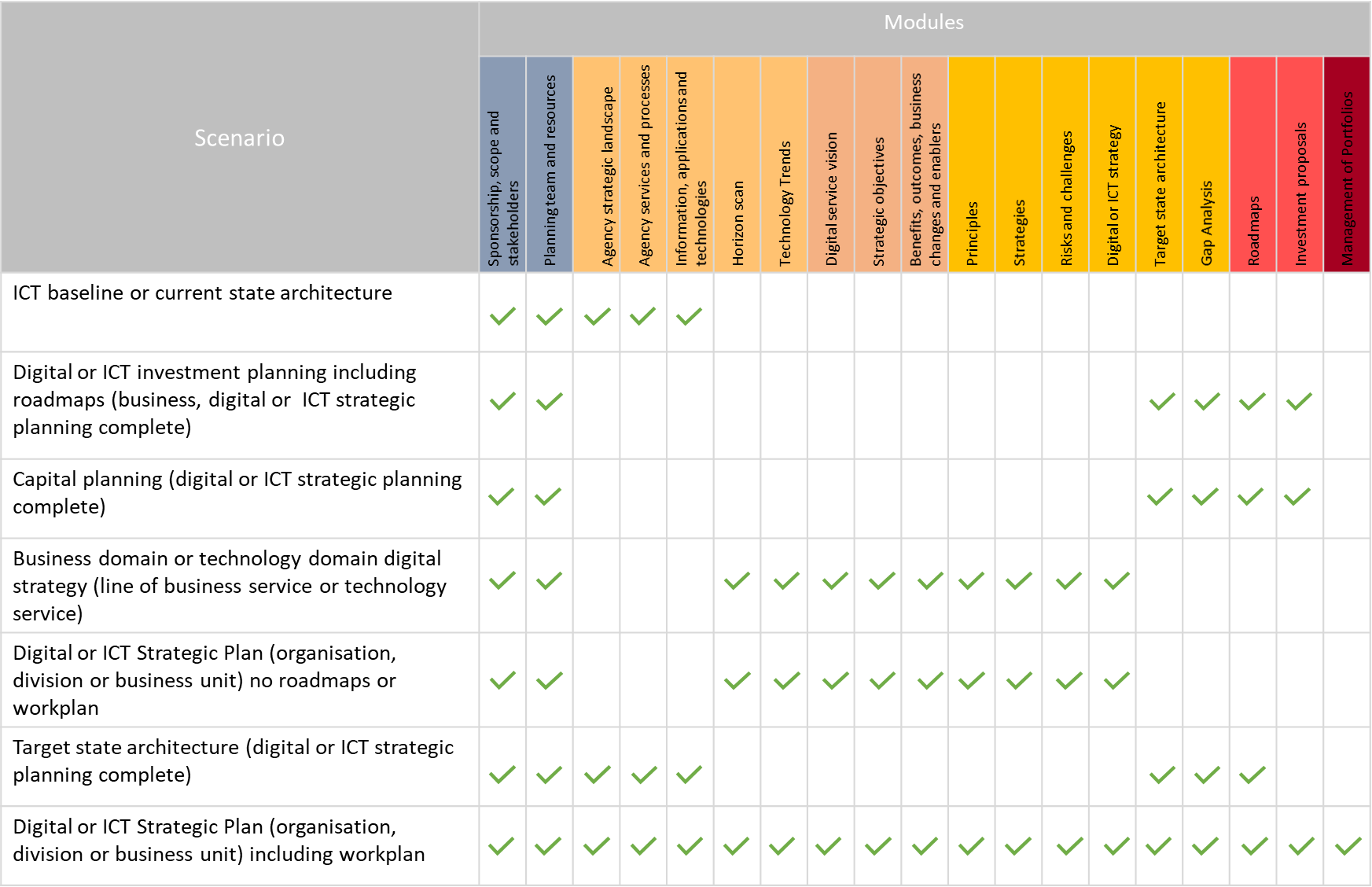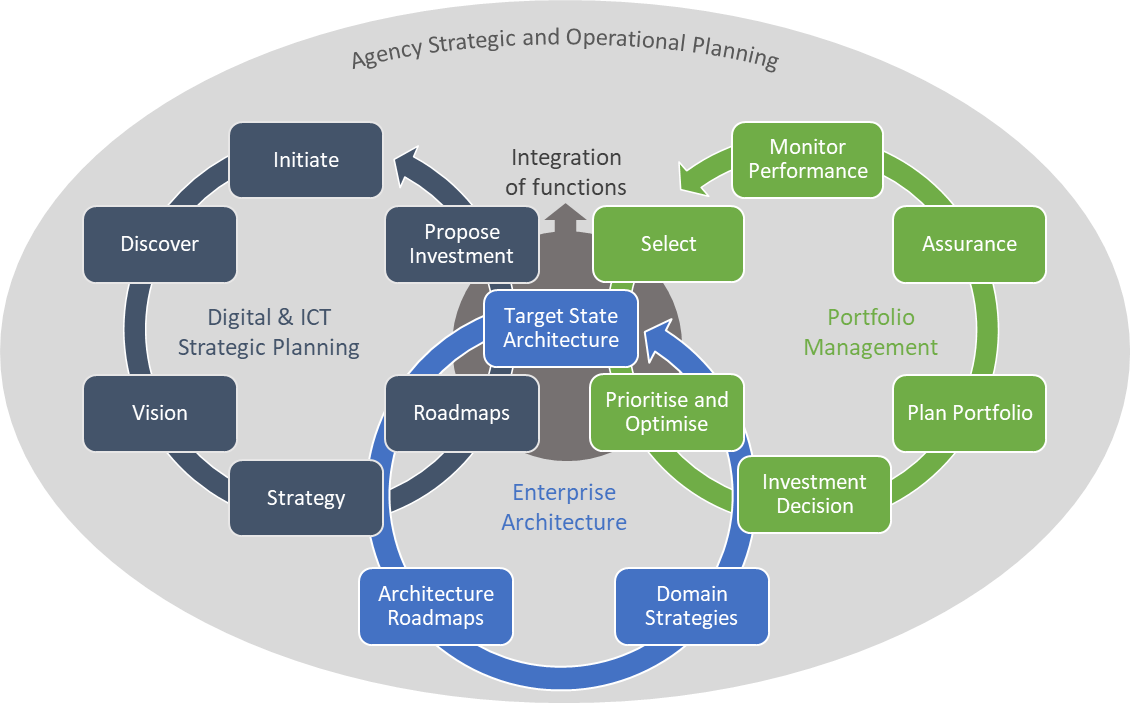Use the digital and ICT strategic framework
The Digital and ICT strategic planning framework can be used by agencies to introduce a structured process for conducting digital and ICT planning, or to complement existing processes in place for digital and ICT strategic planning.
The framework can be used as part of your agency’s annual planning cycle. Some elements may be used more frequently in response to planning opportunities at a business unit or service level.
It is designed to be adapted to fit with agency processes and is deliberately not detailed in areas where agencies might have existing procedures in place (e.g. where PRINCE2 project management is used).
The framework focuses on purpose, guidance and roles rather than prescriptive instructions on how to perform specific tasks or complete specific templates and tools.
How the framework works
The framework consists of workstreams (e.g. Initiate, Discover, Vision) and within those workstreams, modules. The modules are logical bodies of work to be completed and are underpinned by one or more guidelines. For example, within the Initiate workstream, there are 2 modules: Sponsorship, scope and stakeholders, and Planning team and resources.
The guidelines found within each module include how to conduct recommended planning activities, and the purpose, roles, and outputs.
It is not necessary to complete all the modules in the framework as part of every planning engagement. They should be selected based on the purpose of the planning engagement and the planning outputs to be produced (identified in the Initiate workstream). You will always need to complete the Initiate workstream to determine the scope of the planning engagement and the modules as required.
Example planning scenarios and relevant modules
Some modules may never be required because those functions are performed by a different part of the agency and are not part of the digital or ICT planning function (e.g. preparation of initiative proposals may be a portfolio-related function in the agency or performed by the business unit sponsoring the investment).
Successive planning scenarios
Information resulting from initial planning cycles may greatly reduce the amount of work required in subsequent planning cycles, but business objectives and strategies, agency and government drivers, and business services change regularly. Digital capability is also evolving rapidly. It is therefore important during subsequent planning cycles or engagements to ensure the information gathered and used is still relevant, and not assume the information gathered last time is up-to-date.
The outputs from digital strategic planning may also be useful in other agency strategic planning activities and vice versa (i.e ICT workforce planning).
Third party material
While the framework connects you to useful third-party material, this material does not constitute the provision of professional advice. We do not endorse, guarantee, or accept legal liability arising from or connected to, the accuracy, reliability, currency, or completeness or any material contained within this framework.
Contact:
Phone:
Email:
Workstreams and modules
Initiate
The purpose of the planning engagement is established, including appropriate organisational sponsorship. Stakeholders and participants in the planning process are identified and analysed and appropriate engagement strategies are defined. The project engagement is planned at an activity, resource and output level using the modules, guidelines and resources from this framework.
Modules
Discover
Information about the current state of the planning organisation or agency is gathered including the business drivers and strategic direction. A business, information and technology baseline is developed and analysed. Technology and service industry trends and influences are researched within the context of the strategic direction of the agency. Actions and potential strategies resulting from the analysis and research are identified in readiness for the digital and ICT planning activities including workshops.
Modules
Vision
A vision is established with stakeholders for where the agency wants to be in relation to its digital capability. Objectives and strategies are identified that will deliver measurable business benefits. Incremental and measurable changes in digital transformation and technology capability are identified.
Modules
Strategy
The digital or ICT strategy or plans are developed in collaboration with stakeholders. These documents undergo agency wide consultation before being approved. Gaps in capability are identified in preparation for investment planning and prioritisation.
Modules
- Principles
- Strategies
- Risks and challenges
- Digital and ICT strategy or plan
- Target architecture
- Gap analysis
Priorities
Roadmaps and initiative proposals are developed. These form the basis for the prioritisation of investment and are inputs into the agency’s investment prioritisation processes.
Modules
Monitor
The digital transformation of the agency is monitored against the strategies and plans, including the performance of programs and projects in a portfolio of investments. The degree to which benefits are being realised as well as the performance of program and projects are measured in line with best practice methodologies such as Management of Portfolios (MoP)
Modules
Contact:
Phone:
Email:
Roles and responsibilities
The number and types of roles needed to conduct a planning engagement will depend on the scope and nature of the planning work you’re conducting.
Integrated planning approaches using cross functional teams across the disciplines of strategic planning, digital and ICT strategic planning, workforce planning, enterprise architecture as well as investment and portfolio management are recommended. Some of the roles you should consider when establishing a cross functional planning team, and their contribution to the digital and ICT strategic planning process, are outlined below.
Strategic planning
Responsible for engaging with representatives from the business to determine the overall strategic drivers, vision, objectives, strategies as well as high-level outcomes and benefits.
Assists the business representatives to understand the digital or ICT capability required and how it is used in the transformation of services.
Assists the business representatives to initially prioritise the capability required and helps shape an initial view of the areas in investment required over time.
Develops the overall strategy in collaboration with the business representatives.
Roles to be considered
- Agency and service strategic planners.
- Digital and ICT strategic planners.
- Business analysts.
Technology or digital capability
Translates the business, digital or ICT capability required into a target state architecture and roadmap.
Role to be considered
- Enterprise architects.
Information management
Helps the business representatives to identify potential information gaps, improvement opportunities and risks.
Works with enterprise architects to develop an information target state architecture and roadmap in line with the digital or ICT roadmap.
Roles to be considered
- Information managers.
- Strategic information managers.
Information security
Assists the business to identify risks to the confidentiality, integrity and availability of information and information assets.
Roles to be considered
- Information security managers.
- Security architects.
Workforce planning
Helps the business representatives identify potential workforce gaps as well as future roles that might be in demand.
Works with strategic planning specialists to identify future trends in workforce transformation as a result of technology transformation. Identifies the future roles and skills that will be increasingly important to the organisation as well as the strategies required to take advantage of opportunities in the workforce.
Roles to be considered
- Human resource specialists.
- Workforce planners.
ICT investment and portfolio
Works with the business and other streams in the planning team to shape the strategy and required capability into initiatives.
Helps the business refine the benefits and assists them to navigate the governance pathways for funding.
Roles to be considered
- Investment specialists.
- Benefits specialists.
- Business analysts.
- Portfolio specialists.
Marketing and communications
Assists the planning team with editorial reviews as well as the professional presentation of planning outputs.
Present the strategy or plan in new and interesting ways that are meaningful to stakeholders.
Roles to be considered
- Marketing and communications specialists.
- Graphic artists.
- Editorial reviewers.
Integration with other disciplines
At the point where digital and ICT strategies or plans, roadmaps and initiative proposals are developed, there are several important points of integration across functions.
Agency strategic and operational planning
This function supports the agency to establish business and service strategic and operational direction and priorities including the business objectives, strategies and key performance indicators in line with the Queensland Government’s Performance Management Framework.
Enterprise architecture
This function supports the policy and strategic direction required to enable services including technology services in specific areas of capability. It converts the service outputs from integrated digital and ICT planning to produce policies, roadmaps and strategies to enable specific business service and digital capability. These policies, roadmaps and strategies inform the planning, procurement and design activities of individual investments.
Portfolio planning, management and performance
This function examines the optimal mix of investments that can be undertaken across a portfolio taking into consideration aspects such as available funding, capacity to deliver, expected benefits, strategic alignment and the risk profile of current and proposed investments.
The collective investment required to deliver and support a portfolio is typically represented in a portfolio plan. This plan also outlines the objectives, expected benefits and risks of the investment portfolio.
The portfolio function also assists with obtaining funding approval to initiate programs and projects based on the business case.
Contact:
Phone:
Email:
Integration with, and leverage of, other frameworks and planning
Digital and ICT strategic planning must be conducted within the context of an agency’s broader business and service strategic direction.
Agency strategic and operational planning comprises of digital and ICT strategic planning, enterprise architecture and portfolio management.
Portfolio management
The Digital and ICT planning framework complements portfolio management by providing clarity on the strategic objectives of the agency as well as the development of roadmaps and related initiative proposals that can be considered and prioritised against the other competing investment priorities of the agency.
Portfolio management in return provides the basis for determining the scope of the digital and ICT portfolio and the basis for the prioritisation of individual initiatives through the development of initiative proposals.
By collectively analysing all the initiative proposals, portfolio management addresses six fundamental questions:
- Are the programs and projects in our portfolio necessary in the context of our strategic objectives?
- Is the agency’s portfolio, together with BAU activities, sufficient to meet its strategic objectives?
- Is the overall level of risk acceptable?
- Is the portfolio of initiatives achievable?
- Is the portfolio affordable—and if not, which initiatives should be dropped or re-scheduled?
- What are the measures against which the performance of the portfolio will ultimately be assessed?
Through selection and prioritisation of initiative proposals, portfolio management seeks to ensure the agency’s change initiatives represent the optimum allocation of limited resources in the context of the agency’s strategic objectives and broader investment portfolio, and this is maintained if conditions change.
Portfolio management also provides information on the contribution current programs and projects are making to the strategic objectives. This can lead to a change in strategy, based on achievement of unplanned benefits or failure to realise planned benefits.
Portfolio management cycles
Portfolio management does not have a mandated start point, middle or end point but instead includes two continuous cycles of definition and delivery of the portfolio of initiatives and related investment.
The purpose of the portfolio definition cycle is to collate key information that will provide clarity to senior and executive management on the collection of change initiatives which will deliver the greatest contribution to the strategic objectives, subject to consideration of risk, achievability, resource constraints, cost and affordability.
Project management
Where the scope of planning to be conducted is large, in terms of outputs, stakeholders and coverage across the agency, it is recommended the planning activities be managed as a project. Project managers should use their agency-specific project management methodologies or adopt the Queensland Government best practice methodology for project management.
Contact:
Phone:
Email:

